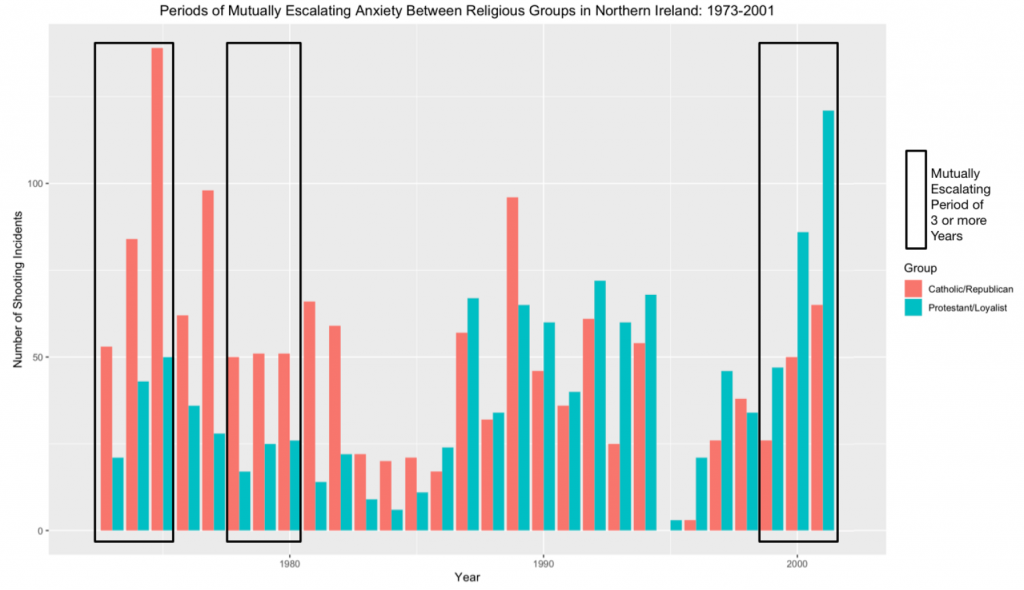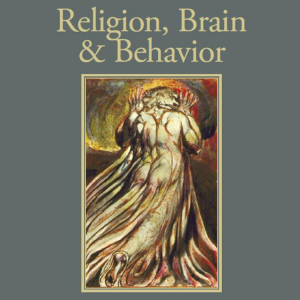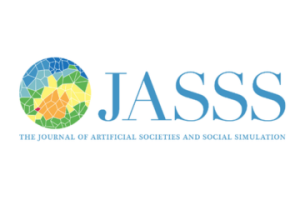Does religion play a causal role in promoting anxiety between groups?
In a recent paper published in the Journal of Artificial Societies and Social Simulation, CMAC researchers collaborated with the Virginia Modeling, Analysis, and Simulation Center (VMASC) to study anxiety and violence between religious groups. Mutually escalating anxiety between religious groups is well documented and can reach a boiling point where it leads to violence. Examples of this include the 2002 Gujurat riots between Hindus and Muslims and the period of violence called The Troubles from 1973-2001 in Northern Ireland between Roman Catholics and Protestants.

How do these mutually escalating contexts between religious groups arise and do they play a role in promoting religiosity?
To answer these questions researchers at CMAC built an agent-based model. The model organizes individuals into a majority and minority group where they interact. The model assumes individuals experience anxiety by perceiving hazards. When individuals do not experience hazards, their anxiety decreases and if enough time passes where an individual does not experience a hazard they become completely calm.
Two types of hazards exist in the model: (1) xenophobic hazards caused by interactions with the other group and (2) environmental hazards that occur independent of interactions with the other group. In the model, when individuals become overly anxious, they identify other anxious members in their group and conduct a religious ritual until everyone participating in the ritual is calm. Due to their inclusion in the ritual the participating individuals become more religious.

See the slides below to understand how the agents acted in the model.
The researchers ran this model millions of times varying the disparity in size between the two groups, the frequency with which each of the two types of hazards occur and the number of individuals needed to conduct a religious ritual. Their results showed that prolonged periods of mutually escalating anxiety between the two groups could occur. However, these periods were rare; periods longer than 8 time steps in the model occurred less than one quarter of one percent (0.25%) of the millions of model runs.

In addition, they showed that that a special set of conditions needed to be present to create lengthy periods of mutually escalating anxiety: the groups needed to be roughly equal in size and the individuals in each group needed to be very xenophobic of one another. These conditions created a situation where individuals in both groups were likely to: (1) encounter someone from the other group (since the groups were roughly equal in size) and (2) be anxious about the encounter (since individuals were very xenophobic of the other group).
Researchers also found that the model run which produced the most religious individuals in both groups featured a prolonged period of mutually escalating anxiety. This occurred because a prolonged period of mutually escalating anxiety created the need for individuals in both groups to make frequent use of religious rituals to calm themselves. However, recall that these rituals also increase the religiosity of the individuals who participate in them, creating calm but more religious individuals.
In combination, these results highlight how important it is for policies related to xenophobic anxiety and violence to focus on increasing individual tolerance of other groups. These policies would decrease the likelihood that individuals in both groups would perceive xenophobic threats. This would reduce the anxiety individuals in each group would experience thereby decreasing the frequency with which religious rituals would be performed as a means to find calmness.
Ultimately, the research demonstrates the promise of using agent-based modeling to grow an unambiguous explanation of a complex social phenomenon. The researchers expect their model will serve as a platform for future work related to xenophobic mutually escalating anxiety and violence.
Citation: Shults, F. LeRon, Gore, Ross, Wildman, Wesley J., Lynch, Christopher, Lane, Justin E. and Toft, Monica (2018). “A Generative Model of the Mutual Escalation of Anxiety Between Religious Groups,” Journal of Artificial Societies and Social Simulation 21 (4) 7.
Read the full paper on JASSS here.
For any inquiries or comments, please email admin@mindandculture.org.



